Shutterbug’s Exclusive photokina Coverage; Weird And Wonderful: With A Nod Toward “Luxury Goods” Page 2
The Luxury Trade
Also on the Monochrom stand were unbelievably lovely leather bags from Carnier, handmade in Provence in the South of France. Starting at around $300 and easily exceeding $400 for the more expensive models, these were one of the products that gave us the idea of focusing on luxury as well as “weird and wonderful.”
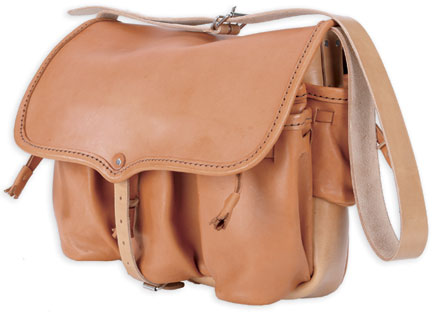 |
|
|
“Luxury” in this context is no more (and no less) than a version of an everyday product that is simply…well…nicer. Most photographers use camera bags; for that matter you can just use an old shopping bag, but Carnier bags, like Billinghams, are just more of a pleasure to use. Incidentally, Carnier bags were originally designed for carrying wine bottles to laborers in the fields: see Luke 10:7 and 1 Timothy 4:23.
The same is true of Artist & Artisan straps and top-of-the-line carbon-fiber and titanium tripods from Gitzo: $100 for a camera strap and $1000 for a tripod makes no sense at all—until you
try them.
Likewise, photographers’ vests are nothing new, but both Gitzo and AquaTech offer (expensive) jackets that are specifically designed for photographers and feature big pockets, “breathable” fabrics, and all the other good stuff. Arguably it should be possible to find other jackets, as useful, elsewhere, and probably cheaper; but equally, a jacket that is designed for photographers has to start at an advantage. We both quite fancy reviewing the Gitzo “system” jackets, in particular, as they really do look very clever.
An interesting aside on luxury came from ALPA. You can now order custom inlays in the handgrips—inlays that are created, by hand, in the US in mother-of-pearl, semiprecious stones, horn, etc., while the handgrips themselves come from a top Swiss manufacturer of gunstocks. Reckon on at least $1000 on top of the price of the camera, quite possibly a lot more, and a delay of several weeks or even months. But ALPA says, “We started out as a luxury brand, but now we sell mostly just professional tools. Next to a high-end digital back, an ALPA isn’t expensive, and there’s no other easy way to get the kind of precision we offer.”
Making Life Easier
Never mind luxury: there are plenty of products that are simply designed to make life easier. For example, an ingenious and very simple solution to keeping color temperature constant came from Dedolight: four miniature tungsten-halogen bulbs mounted on a cross shape. They’re so small, and so close together, that once they’re behind any kind of diffuser, they perform as a single light source. You want to dim the light without changing the color temperature? Switch ’em off, one at a time…
 |
 |
||
|
|
A similar trick comes from Lastolite: a bounce/shoot through umbrella with a bracket for three reasonably powerful shoe-mount flash guns. Use all three together and you are getting close to a studio flash head; turn ’em off one by one and you have a useful degree of control.
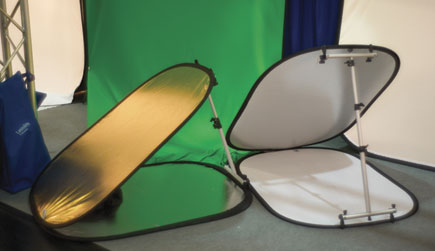 |
|
|
Lastolite also had a very simple, very effective bounce holder. Take two of their collapsible bounces; hinge them at one end; at the other, provide a simple, extensible arm. One end rests on the ground; the other supports the upper bounce. Each bounce has two faces: silver, gold, white, whatever. Finish the whole thing off with a stretchy ground cover or “slipper” to protect the bounce that’s face-down on the ground, and you have the equivalent of an assistant to hold each of four bounces for you, vastly simplifying fill lighting, especially in the open.
An unclassifiable product that we admired came from FOBA and FotoRobot. It was a simple turntable, plus associated software for 3D product photography. Rotate; stop; shoot; rotate; stop; shoot… Soon you have enough pictures to feed through the appropriate software and display the product on a screen, slowly rotating so you can see each side of it. Note “slowly”: some of these 3D displays whizz around so fast that you get giddy watching them, quite apart from the fact that there is no time to see the product (though maybe that’s deliberate).
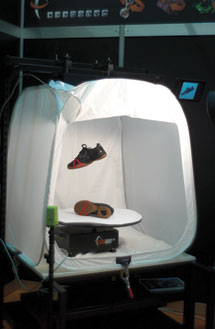 |
 |
||
|
|
Back to Lastolite again, there was a combination softbox and trans-illuminated background that is easier to illustrate than to describe. Suffice it to say that if you want to shoot portraits against a pure white background, it’s brilliant, but you’d better have a good, contrasty lens to suppress veiling flare.
Thinking of flare, the i-Visor laptop case from Calumet Photographic incorporates a hood for viewing under bright lights: such hoods are nothing new, but building one into a laptop case is.
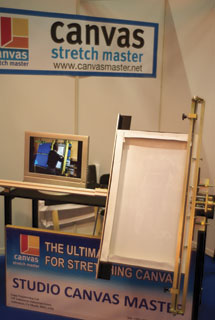 |
|
|
In another realm entirely were Canvas Stretch Master machines from Gapp Engineering in Ireland. The cheapest manual model was under 1000 euros (well under $1500): bigger, fully auto models run into the thousands. Canvas prints are ever more popular, and anyone who has ever tried stretching canvas by hand will know exactly why a machine like this is a dream come true. Yes, it’s expensive, but if you stretch many canvases the savings in spoiled materials, to say nothing of pain and suffering, are likely to be considerable. When you’re painting, after all, you stretch the canvas before you create the picture. With a photograph on canvas, you’re stretching the final image.
Big Stuff
There are plenty more things at photokina that are unlikely to sell to the average amateur, or indeed to the average professional, but which even so, many of us may end up using, or at least, benefiting from.
 |
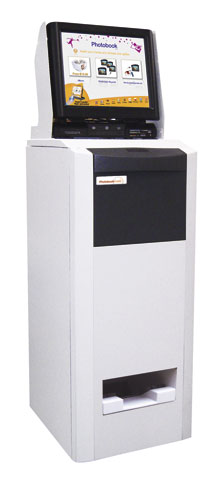 |
||
|
|
For example, there’s the battery recharging booth from Photo-Me. It’s simple: a coin-in-the-slot locker, into which you can put whatever needs recharging—camera battery, laptop battery, phone battery—and recharge it for a couple of hours. Dull; ordinary; boring; and a brilliant idea.
Photo-Me also had an automated photo-book machine. Photo books—printed on demand albums in book form—are increasingly mainstream, but they’re mostly mail order or order-from-store. This is just kiosk-in-store; the press release says that a 20-page “book” takes around 6 minutes to produce, and that on average, 23 books can be made before the machine needs refilling.
 |
|
|
Photo books are of course a part of that overused marketing phrase “picture sharing.” Tacky though the phrase might be, it’s also quite useful, and another example of it comes from Sticker Boy (honestly!) which is a machine for producing, you’ve guessed it, photo stickers and magnetic-backed pictures you can stick on your refrigerator. Obviously it’s a “bureau” job—you don’t want one at home—but look out for camera stores lively enough to install such a thing.
 |
|
|
Something else that is impossibly big and expensive for most photographers is an automatic art-copying stand, the XXL-Fototisch. Put the painting (or book, or any other rigid, rectangular item) on the base, and press a button. Sliding arms automatically but gently square it up; a remote control moves the camera up and down, and focuses it under soft, oblique lighting; and you press the button. It does the rest. A few days before photokina we had to photograph several paintings and drawings. This would have saved half the time we spent doing it, and given better results to boot.
Smaller, but in the same general category, Kaiser’s “Book Cradle” is an impressively clever piece of kit that supports books for photographic copying—you’d never have guessed that, would you? Yes, it’s expensive, but if we could afford one, we’d be tempted. It’s brought to the US by HP Marketing Corp.
We said we’d save the weirdest ’til last, so here it is: the ever-wider adoption of Sony’s automatic smile recognition software. This strikes us as the most wonderful creative challenge, jointly for the photographer and his/her subjects. How far can you get from a smile, and still persuade the camera to read it as a smile?
Manufacturers/Distributors’ website addresses can be found by visiting the Instant Links section of our website at: www.shutterbug.com/currentissuelinks/. The websites can also be found in the “Resources” section on our homepage under “Manufacturers/Distributors.”
- Log in or register to post comments

































